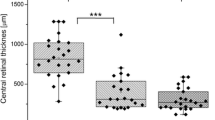Abstract
Purpose To evaluate by multifocal electroretinography (MFERG) and optical coherence tomography (OCT) the effectiveness of intravitreal use of bevacizumab (Avastin) in the treatment of macular edema due to central retinal vein occlusion (CRVO). Methods A total of 10 eyes of 10 patients (six males and four females) with macular edema due to CRVO were studied before and after intravitreal use of bevacizumab with MFERG and OCT. The post treatment follow-up was 3 months. Examination included measurement of best-corrected visual acuity (BCVA) for distance, measurement of intraocular pressure (IOP), fluorescein angiography, foveal-retinal thickness measurement by OCT, and MFERG recordings before treatment and 1 and 3 months after treatment. Results Before treatment, OCT shows an increase of the retinal thickness of the fovea. About 1 and 3 months after treatment the foveal thickness decreased to a significant level. The electrical responses in the fovea and parafovea of the MFERG recording depicted a significant improvement at 1 and 3 months after the injection. No patient manifested IOP increase. Conclusion The intravitreal use of bevacizumab may provide anatomical and functional amelioration of the macula in patients with macular edema due to CRVO. However, further study is needed in order to assess the treatment’s long-term efficacy.



Similar content being viewed by others
References
The Central Vein Occlusion Study Group (1997) Natural history and clinical management of central retinal vein occlusion. Arch Ophthalmol 115:486–491
The Central Vein Occlusion Study Group (1995) Evaluation of grid laser pattern photocoagulation for macular edema in central vein occlusion. Ophthalmology 102:1425–1433
Noma H, Minamoto A, Funatsu H et al (2006) Intravitreal levels of endothelial growth factor and interleukin-6 are connected with macular edema in branch retinal vein occlusion. Graefes Arch Clin Exp Ophthalmol 244:309–315
Spandau UH, Ihlorf AK, Jost BJ (2006) Intravitreal bevacizumab treatment of macular oedema due to central retinal vein occlusion. Acta Ophthalmol Scand 84:555–556
Iturralde D, Spaide RF, Meyerle CB et al (2006) Intravitreal bevacizumab (Avastin) treatment of macular edema in central retinal vein occlusion: a short-term study. Retina 26:279–284
Costa RA, Jorge R, Calluci D, Melo L, Cardilllo J, Scott IU (2007) Intravitreal bevacizumab (Avastin) for central and hemicentral retinal vein occlusions: IBeVO study. Retina 27:141–149
Spandau U, Wickenhauser A, Rench F, Jonas J (2007) Intravitreal bevacizumab for branch retinal vein occlusion. Acta Ophthalmol Scand 85:118
Sutter E, Tran D (1992) The field topography of ERG components in man-I. The photopic luminance response. Vision Res 32:433–446
Hood D (2000) Assessing retinal function with the multifocal technique. Prog Retin Eye Res 19:607–646
Marmor MF, Hood DC, Keating D, Kondo M, Seeliger MW, Miyake Y (2003) International Society for Clinical Electrophysiology of Vision. Guidelines for basic multifocal electroretinography (mfERG). Doc Ophthalmol 106(3):338
Rosenfeld PG, Fung AE, Pulliafito CA (2005a) Optical coherence tomography findings after intravitreal injection of bevacizumab (Avastin) from macular edema from central retinal vein occlusion. Ophthalmic Surg Lasers Imaging 36:336–339
Rosenfeld PG, Moshfeghi AA, Puliafito CA (2005b) Optical coherence tomography findings after an intravitreal injection of bevacizumab (Avastin) for neovascular age-related macular degeneration. Ophthalmic Surg Lasers Imaging 36:331–335
Ip M, Kahama A, Altaweel M (2003) Treatment of central retinal vein occlusion with triamcinolone acetonide: an optical coherence tomography study. Semin Ophthalmol 18:67–73
Author information
Authors and Affiliations
Corresponding author
Rights and permissions
About this article
Cite this article
Moschos, M.M., Moschos, M. Intraocular bevacizumab for macular edema due to CRVO. A multifocal-ERG and OCT study. Doc Ophthalmol 116, 147–152 (2008). https://doi.org/10.1007/s10633-007-9110-9
Received:
Accepted:
Published:
Issue Date:
DOI: https://doi.org/10.1007/s10633-007-9110-9




